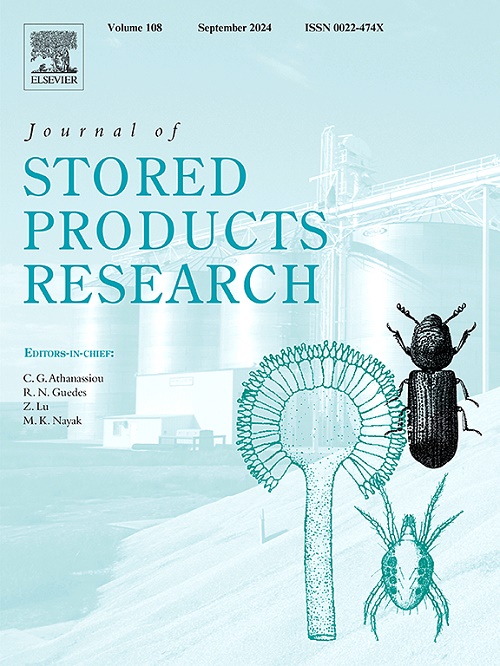用4,8-二甲基十二醛和商用凯罗酮诱捕器监测阿维菌素对褐飞蛾(鞘翅目:拟甲科)成虫的影响
IF 2.7
2区 农林科学
Q1 ENTOMOLOGY
引用次数: 0
摘要
聚群性信息素4,8-二甲基癸醛(4,8- dmd)和市售的凯酮用于诱捕castaneum,这是一种严重的储存性害虫,但通常报道的诱捕率较低。以前的研究报告说,接触某些化学物质会增强它们的捕获能力,但杀虫剂阿维菌素的影响尚不清楚。本研究旨在确定暴露于阿维菌素的蓖麻子对随后定向的影响,陷阱含有其聚集信息素4,8-二甲基十二醛和一个凯罗酮。在实验室条件下,信息素诱捕效果在7.5 ppm时相似,然后在10、15和20 ppm时诱捕效果降低。在2.5 ppm时,对费洛蒙+凯洛蒙瓶的吸引力最高(53%),高于未接触阿维菌素的成虫。总的来说,当阿维菌素浓度超过2.5 ppm时,捕集量就会随着浓度的增加而减少。在模拟仓库条件下,暴露于1 ppm阿维菌素的昆虫捕获率最高(29%),与0 ppm(无信息素)和2.5 ppm无显著差异。15 ppm时捕集率最低(8%),与20 ppm时差异不显著。以信息素+凯洛蒙处理,0 ppm阿维菌素处理的捕集率最高(48.75%),与2.5 ppm阿维菌素处理无显著差异,20 ppm阿维菌素处理的捕集率最低(11%)。诱捕器中信息素和kairoone联合使用比单独使用信息素捕获的昆虫更多。但是,暴露于高浓度阿维菌素减少了暴露后14天的捕获。因此,未来的研究需要安排阿维菌素的预处理,这样它就不会危及通过费洛蒙和/或卡洛蒙陷阱进行的监测工作,以确保储存的食物不受昆虫损害。本文章由计算机程序翻译,如有差异,请以英文原文为准。
Monitoring of Tribolium castaneum (Coleoptera: Tenebrionidae) adults following exposure to abamectin by traps with 4,8-dimethyldecanal and commercial kairomone
The aggregation pheromone 4,8-dimethyldecanal (4,8-DMD) and commercially-available kairomones are used for trapping Tribolium castaneum, a serious stored-product pest insect but low trapping is often reported. Previous studies reported that exposure to certain chemicals enhanced their trapping but the influence of the insecticide abamectin is not known. This research aimed to determine the effect of exposing T. castaneum to abamectin on subsequent orientation to traps containing its aggregation pheromone 4,8-dimethydecanal and a kairomone. Under laboratory conditions, trapping with pheromone was similar up to 7.5 ppm, then trapping was reduced at 10, 15 and 20 ppm. The highest attraction (53%) to pheromone + kairomone vial observed at 2.5 ppm which was greater than adults not exposed to abamectin. Overall, trapping decreased with increasing concentrations of abamectin beyond 2.5 ppm. Under simulated warehouse conditions, the highest trapping (29%) occurred in insects exposed to 1 ppm abamectin and was not significantly different from 0 ppm (no pheromone) and 2.5 ppm. The lowest trapping (8%) occurred at 15 ppm which was not significantly different than 20 ppm. With pheromone + kairomone, the highest trapping (48.75%) obtained in adults exposed to 0 ppm abamectin which was not significantly different than 2.5 ppm exposure while the lowest recapture was 11% at 20 ppm. The combination of pheromone and kairomone in traps captured more insects than pheromone alone. But, exposure to high concentrations of abamectin reduced trapping at 14 d following exposure. Therefore, future research needs to schedule the pre-treatment with abamectin so that it will not jeopardize monitoring efforts through pheromone and/or kairomone traps to ensure protection of stored food from insect damage.
求助全文
通过发布文献求助,成功后即可免费获取论文全文。
去求助
来源期刊
CiteScore
5.70
自引率
18.50%
发文量
112
审稿时长
45 days
期刊介绍:
The Journal of Stored Products Research provides an international medium for the publication of both reviews and original results from laboratory and field studies on the preservation and safety of stored products, notably food stocks, covering storage-related problems from the producer through the supply chain to the consumer. Stored products are characterised by having relatively low moisture content and include raw and semi-processed foods, animal feedstuffs, and a range of other durable items, including materials such as clothing or museum artefacts.

 求助内容:
求助内容: 应助结果提醒方式:
应助结果提醒方式:


